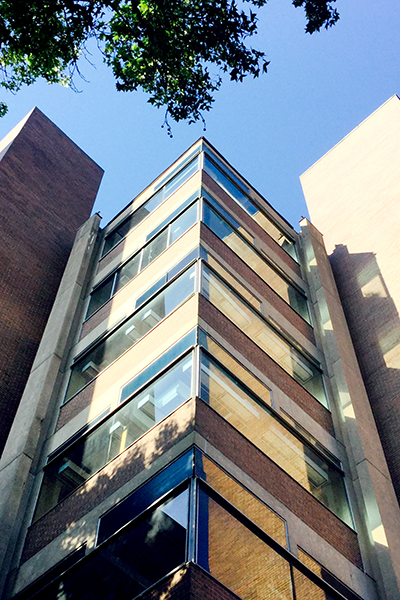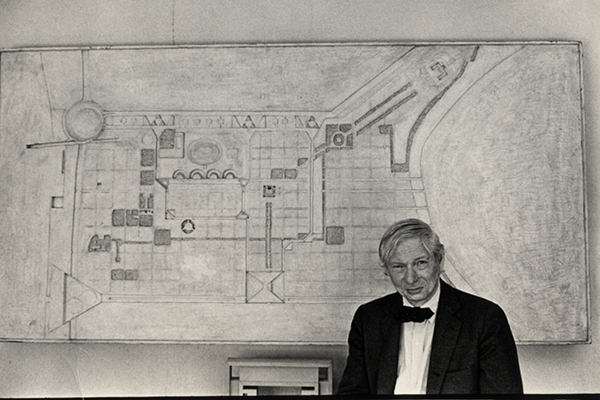The Work of Philadelphia Architect Louis Kahn
The work of Philadelphia architect Louis I. Kahn has received much academic attention at Penn recently. An exhibit at the Kroiz Gallery of the Penn Architectural Archives (located in the Fisher Fine Arts Building) showcases one of Mr. Kahn’s most unusual projects, a barge for the American Wind Symphony Orchestra. Completed in 1974, it was originally docked in Biloxi, Mississippi and is now located in London, England. This barge features a clamshell roof that opens when the vessel is docked to provide an acoustically sound concert shell, but closes while the barge is traveling.
This exhibit features a wide array of documents pertaining to Mr. Kahn including sketches and models of the barge, period photos and historic film footage. The exhibit will be on display through November 13. A series of events in conjunction with the exhibit include the following:
- On Wednesday, October 25, Penn’s Architectural Archives curator William Whitaker will present a talk, Uncrating Kahn, from 6:30-8 p.m. at Meyerson Hall, discussing Mr. Kahn’s Philadelphia architecture and the creation of the exhibit. Register for this free talk at Eventbrite.
- On Saturday, October 28, Penn’s graduate architecture program will host a daylong event called Louis I. Kahn: My Teacher, My Friend, My Father, My Architect. Located in the lower gallery and room B1 of Meyerson Hall, this event will include panels featuring Mr. Kahn’s children and colleagues. The day will conclude with a screening of My Architect: A Son’s Journey, a film spotlighting Mr. Kahn’s life and works, followed by a Q&A with filmmaker—Mr. Kahn’s son, Nathaniel Kahn. Tickets are $25 for the entire event, $10 for only the film screening and free for Penn students with ID. Register at Eventbrite.
Mr. Kahn was not only one of the 20th century’s most influential architects and the “spiritual father of the architectural tradition at Penn,” but he was an internationally known architect, educator and philosopher. He trained at Penn in the Beaux-Arts under Paul Philippe Cret from 1920-1924 and returned to Penn to teach from 1955 until his death at the age of 73 in 1974 (Almanac March 26, 1974).
Born in 1901 on the Baltic island of Osel, Estonia, Mr. Kahn came to America in 1905. He attended Central High School in Philadelphia before coming to Penn for his bachelor’s degree. He established an independent practice in 1947 and began teaching at Yale the same year. In 1955, he was appointed to a professorship at Penn, where he became the first to hold the Cret Professor of Architecture in 1966, created by a bequest from his own teacher. Mr. Kahn’s teaching and buildings helped spread new, modern ideas about the use of light and space in urban architecture.
In 1957, Mr. Kahn embarked on a Penn building, the Richards Medical Research Laboratory, which was completed in 1960. The Alfred Newton Richards Medical Research Building was dedicated on May 19, 1960 (Almanac June 1960). Dr. Richards, emeritus professor of pharmacology and former vice president for medical affairs, for whom the building was named, took part with Penn President Gaylord Harnwell and other educators and medical leaders in dedicating the $3,100,000 structure on Hamilton Walk. The Richards Building was immediately acclaimed “for a bold design that brilliantly redefined modern architecture.” The towers themselves rise prominently above the common roof-level of the building, giving an effect of aspiration which, as President Harnwell pointed out, symbolize a “reaching for new understanding of the phenomena of human life and health, new powers to conserve them.” His other building, the Goddard Laboratory, was finished next door in 1964. Both Richards and Goddard Labs are now on the National Historic Landmark list (Almanac April 12, 2016). They remain an integral part of Penn’s campus and a key entry in Mr. Kahn’s innovative oeuvre.
The Richards Labs are composed of a group of connected vertical volumes whose interior functions are expressed by differing exterior treatments. The laboratories are marked by corner windows, and supported and separated by cantilevered structural, pre‑cast concrete beams and horizontal bands of brick veneer. The mechanical and circulation functions of the building are contained in tall brick‑faced towers rising above laboratory sections.
As part of Penn Connects 2.0 (Almanac July 17, 2012), the Richards Building is undergoing renovation. Its windows are being replaced with more energy-efficient glass, wet lab space is being converted to offices, conference rooms, and lobby spaces, and HVAC and lighting improvements are being implemented. The first phase of this project, which saw one half of the building updated, was completed in fall 2015; the other half of the building is projected to be finished in spring 2019.

Louis Kahn’s Richards Medical Research Laboratory, completed in 1960, is undergoing renovations that are scheduled to be completed in 2019. Photo by Jackson Betz.

This drawing of Louis Kahn’s symphony barge is one of many artifacts on display at the Kroiz Gallery through November 13. Drawing courtesy of Penn’s Architectural Archives.

Louis Kahn is the focus of a PennDesign exhibit and several related events this semester. Photo courtesy of PennDesign.
